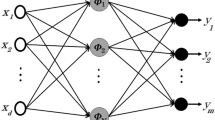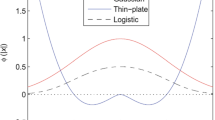Abstract
The current abundance of the collected biomedical data provides an important tool for the development of medical data classification systems. However, processing big data requires powerful algorithms. In this perspective, we propose a hybrid classifier that combines radial basis function (RBF) and extreme learning machine (ELM) neural networks. This combination is motivated by the high performances and the complementary of these two types of neural networks. The basic idea relies on complementing a compact RBF network by an ELM network that contains a diversity of hidden neurons. The optimization of the number, forms, and types of the ELM hidden neurons is performed using a genetic algorithm (GA). The objectives of the proposed classifier can be summarized as follows. First, it benefits from the complementary properties of RBF and ELM, like local response of RBFs and global response of ELM. Second, it makes use of the advantages of ELM, like fast training and the possibility of using a variety of activation functions. Third, it alleviates the ill conditioning problem of ELM by joining the systematic initialization of RBF to the random initialization of ELM. Fourth, the optimization process, performed using GA, is simplified because it concerns only the added neurons, which their role is complementing the RBF network. To assess the performance of the proposed classifier, we carry out tests on six medical datasets from the UCI machine learning repository and compare the obtained results with those of other state-of-the-art works. The obtained average performance measurement, i.e., accuracy, sensitivity, and specificity for Wisconsin breast cancer are 97.38%, 98.38%, 96.85%, for Pima Indians diabetes are 77.61%, 57.35%, 88.22%, for heart Statlog are 83.71%, 77.92%, 88.34%, for hepatitis are 87.10%, 95.89%, 40.10%, for Parkinson are 92.62%, 96.50%, 80.76%, and for liver-disorders are 72.48%, 82.68%, 58.39% respectively








Similar content being viewed by others
Explore related subjects
Discover the latest articles, news and stories from top researchers in related subjects.References
Broomhead DS, Lowe D (1988) Radial basis functions, multi-variable functional interpolation and adaptive networks. Royal Signals and Radar Establishment Malvern (United Kingdom)
Huang W, Oh SK, Pedrycz W (2014) Design of hybrid radial basis function neural networks (HRBFNNs) realized with the aid of hybridization of fuzzy clustering method (FCM) and polynomial neural networks (PNNs). Neural Netw 60:166–181
Alexandridis A, Chondrodima E, Sarimveis H (2016) Cooperative learning for radial basis function networks using particle swarm optimization. Appl Soft Comput 49:485–497
Cruz DPF, Maia RD, da Silva LA, de Castro LN (2016) BeeRBF: a bee-inspired data clustering approach to design RBF neural network classifiers. Neurocomputing 172:427–437
Cheruku R, Edla DR, Kuppili V (2017) Diabetes classification using radial basis function network by combining cluster validity index and bat optimization with novel fitness function. Int J Comput Intell Syst 10(1):247–265
Hu Y, You JJ, Liu JN, He T (2018) An eigenvector based center selection for fast training scheme of RBFNN. Inf Sci 428:62–75
Aljarah I, Faris H, Mirjalili S, Al-Madi N (2018) Training radial basis function networks using biogeography-based optimizer. Neural Comput Appl 29(7):529–553
Dey P, Gopal M, Pradhan P, Pal T (2019) On robustness of radial basis function network with input perturbation. Neural Comput Appl 31(2):523–537
Roguia S, Mohamed N (2019) An optimized RBF-neural network for breast cancer classification. Int J Inform Appl Math 1(1):24–34
Siouda R, Nemissi M, Seridi H (2020) A genetic algorithm-based deep RBF neural network for medical classification. In: Proceedings of the 1st international conference on intelligent systems and pattern recognition, pp 27–32
Huang GB, Zhu QY, Siew CK (2006) Extreme learning machine: theory and applications. Neurocomputing 70(1–3):489–501
Chen X, Xie W, Yu S (2020) Body fat percentage prediction algorithm based on PSO-ELM model and BIA. In Proceedings of 2020 the 6th international conference on computing and data engineering, pp 5–8
Tian Z, Ren Y, Wang G (2019) Short-term wind speed prediction based on improved PSO algorithm optimized EM-ELM. Energy Sources Part A: Recovery Util Environ Eff 41(1):26–46
Nemissi M, Salah H, Seridi H (2018) Breast cancer diagnosis using an enhanced extreme learning machine based-neural network. In 2018 international conference on signal, image, vision and their applications (SIVA), pp 1–4. IEEE
Alencar AS, Neto ARR, Gomes JPP (2016) A new pruning method for extreme learning machines via genetic algorithms. Appl Soft Comput 44:101–107
Mohapatra P, Chakravarty S, Dash PK (2015) An improved cuckoo search based extreme learning machine for medical data classification. Swarm Evol Comput 24:25–49
Zhu QY, Qin AK, Suganthan PN, Huang GB (2005) Evolutionary extreme learning machine. Pattern Recogn 38(10):1759–1763
Huang GB, Siew CK (2004) Extreme learning machine: RBF network case. In: ICARCV 2004 8th control, automation, robotics and vision conference, 2004, vol 2, pp 1029–1036. IEEE
Xu X, Tian S (2016) ELM-RBF neural networks using micro-genetic algorithm for optimization. Int J Hybrid Inf Technol 9(12):27–36
Wu Y, Chen Z, Wu L, Lin P, Cheng S, Lu P (2017) An intelligent fault diagnosis approach for PV array based on SA-RBF kernel extreme learning machine. Energy Procedia 105:1070–1076
Xu X, Shan D, Li S, Sun T, Xiao P, Fan J (2019) Multi-label learning method based on ML-RBF and Laplacian ELM. Neurocomputing 331:213–219
Wen H, Fan H, Xie W, Pei J (2017) Hybrid structure-adaptive RBF-ELM network classifier. IEEE Access 5:16539–16554
Xia L, Hu P, Ma K, Yang L (2021) Research on measurement modeling of spherical joint rotation angle based on RBF-ELM network. IEEE Sens J 21(20):23118–23124
Qasem SN, Shamsuddin SM (2010) Generalization improvement of radial basis function network based on multi-objective particle swarm optimization. J Artif Intell 3(1):1–16
Deng W, Zheng Q, Chen L (2009) Regularized extreme learning machine. In: 2009 IEEE symposium on computational intelligence and data mining, pp 389–395. IEEE
Garcia-Capulin CH, Cuevas FJ, Trejo-Caballero G, Rostro-Gonzalez H (2015) A hierarchical genetic algorithm approach for curve fitting with B-splines. Genet Program Evolvable Mach 16(2):151–166
Melin P, Sánchez D (2019) Optimization of type-1, interval type-2 and general type-2 fuzzy inference systems using a hierarchical genetic algorithm for modular granular neural networks. Granul Comput 4(2):211–236
Zhao G, Shen Z, Man Z (2011) Robust input weight selection for well-conditioned extreme learning machine. Int J Inf Technol 17(1):1–13
Han F, Yao HF, Ling QH (2013) An improved evolutionary extreme learning machine based on particle swarm optimization. Neurocomputing 116:87–93
Li B, Li Y, Rong X (2013) The extreme learning machine learning algorithm with tunable activation function. Neural Comput Appl 22(3):531–539
Ertuğrul ÖF (2018) A novel type of activation function in artificial neural networks: trained activation function. Neural Netw 99:148–157
López-Rubio E, Ortega-Zamorano F, Domínguez E, Muñoz-Pérez J (2019) Piecewise polynomial activation functions for feedforward neural networks. Neural Process Lett 50(1):121–147
Farhadi F, Nia VP, Lodi A (2019) Activation adaptation in neural networks. arXiv preprint arXiv:1901.09849
Qian S, Liu H, Liu C, Wu S, San Wong H (2018) Adaptive activation functions in convolutional neural networks. Neurocomputing 272:204–212
Huang GB (2014) An insight into extreme learning machines: random neurons, random features and kernels. Cogn Comput 6(3):376–390
Huang GB, Zhou H, Ding X, Zhang R (2011) Extreme learning machine for regression and multiclass classification. IEEE Trans Syst Man Cybern Part B (Cybern) 42(2):513–529
Nemissi M, Seridi H, Akdag H (2014) One-against-all and one-against-one based neuro-fuzzy classifiers. J Intell Fuzzy Syst 26(6):2661–2670
Benoudjit N, Archambeau C, Lendasse A, Lee JA, Verleysen M (2002) Width optimization of the Gaussian kernels in radial basis function networks. In: ESANN, vol 2, pp 425–432
Bache K, Lichman M (2013) UCI machine learning repository
Rafało M (2021) Cross validation methods: analysis based on diagnostics of thyroid cancer metastasis. ICT Express
Mantas CJ, Abellan J (2014) Credal-C4. 5: decision tree based on imprecise probabilities to classify noisy data. Expert Syst Appl 41(10):4625–4637
Jiang L, Li C, Wang S, Zhang L (2016) Deep feature weighting for Naive Bayes and its application to text classification. Eng Appl Artif Intell 52:26–39
Cheruku R, Edla DR, Kuppili V, Dharavath R (2017) PSO-RBFNN: a PSO-based clustering approach for RBFNN design to classify disease data. In: International conference on artificial neural networks, pp 411–419. Springer, Cham
Islam MM, Haque MR, Iqbal H, Hasan MM, Hasan M, Kabir MN (2020) Breast cancer prediction: a comparative study using machine learning techniques. SN Comput Sci 1(5):1–14
Bousmaha R, Hamou RM, Amine A (2021) Automatic selection of hidden neurons and weights in neural networks for data classification using hybrid particle swarm optimization, multi-verse optimization based on Lévy flight. Evolut Intell, 1–20
Beheshti Z, Shamsuddin SMH, Beheshti E, Yuhaniz SS (2014) Enhancement of artificial neural network learning using centripetal accelerated particle swarm optimization for medical diseases diagnosis. Soft Comput 18(11):2253–2270
Raitoharju J, Kiranyaz S, Gabbouj M (2015) Training radial basis function neural networks for classification via class-specific clustering. IEEE Trans Neural Netw Learn Syst 27(12):2458–2471
Edla DR, Cheruku R (2017) Diabetes-finder: a bat optimized classification system for type-2 diabetes. Procedia Comput Sci 115:235–242
Santhanam T, Ephzibah EP (2015) Heart disease prediction using hybrid genetic fuzzy model. Indian J Sci Technol 8(9):797
PhysioNet (2001) PhysioNet: MIT-BIH arrhythmia database. Phys-ioNet: MIT-BIH arrhythmia database. https://archive.physionet.org/cgi-bin/atm/ATM. Accessed 30 Jan 2022
De Chazal P, O’Dwyer M, Reilly RB (2004) Automatic classification of heartbeats using ECG morphology and heartbeat interval features. IEEE Trans Biomed Eng 51(7):1196–1206
Wang T, Lu C, Yang M, Hong F, Liu C (2020) A hybrid method for heartbeat classification via convolutional neural networks, multilayer perceptrons and focal loss. PeerJ Comput Sci 6:e324
Wang H, Shi H, Lin K, Qin C, Zhao L, Huang Y, Liu C (2020) A high-precision arrhythmia classification method based on dual fully connected neural network. Biomed Signal Process Control 58:101874
Siouda R, Nemissi M, Seridi H (2021) ECG beat classification using neural classifier based on deep autoencoder and decomposition techniques. Prog Artif Intell 10(3):333–347
Yan Z, Zhou J, Wong WF (2021) Energy efficient ECG classification with spiking neural network. Biomed Signal Process Control 63:102170
Houssein EH, Ibrahim IE, Neggaz N, Hassaballah M, Wazery YM (2021) An efficient ECG arrhythmia classification method based on Manta ray foraging optimization. Expert Syst Appl 181:115131
Siouda R, Nemissi M, Seridi H (2022) A random deep neural system for heartbeat classification. Evolv Syst, 1–12
Wang D, Chen Y, Shen C, Zhong J, Peng Z, Li C (2022) Fully interpretable neural network for locating resonance frequency bands for machine condition monitoring. Mech Syst Signal Process 168:108673
Colace F, Loia V, Tomasiello S (2019) Revising recurrent neural networks from a granular perspective. Appl Soft Comput 82:105535
Tomasiello S, Loia V, Khaliq A (2021) A granular recurrent neural network for multiple time series prediction. Neural Comput Appl 33(16):10293–10310
Author information
Authors and Affiliations
Corresponding author
Additional information
Publisher's Note
Springer Nature remains neutral with regard to jurisdictional claims in published maps and institutional affiliations.
Rights and permissions
About this article
Cite this article
Siouda, R., Nemissi, M. & Seridi, H. Diverse activation functions based-hybrid RBF-ELM neural network for medical classification. Evol. Intel. 17, 829–845 (2024). https://doi.org/10.1007/s12065-022-00758-3
Received:
Revised:
Accepted:
Published:
Issue Date:
DOI: https://doi.org/10.1007/s12065-022-00758-3




